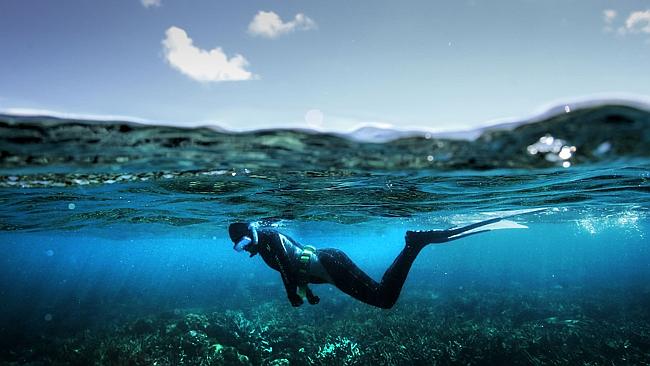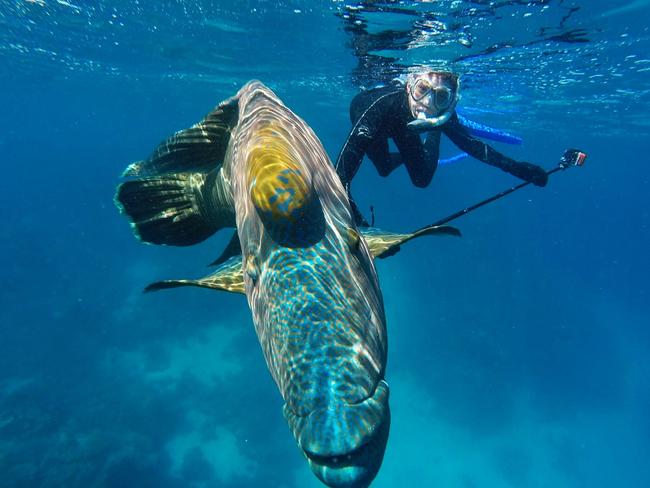Action on fixing the Great Barrier Reef is “urgent”
AUSTRALIA’S prosperity is at stake and our international reputation is on the line. There is no time to lose to fix this problem.

ACTION on fixing the Great Barrier Reef is “urgent” and solutions must be identified to address a problem that has left Australia facing economic catastrophe.
Australia came dangerously close to seeing one of its prized tourist attractions listed on UNESCO’s “in danger” list last month and the economic ramifications of such a listing have been made clear.
The reef contributes about $6 billion a year to the Australian economy and the Queensland Tourism Industry Council said an “in danger” listing would have been “catastrophic” for the industry. It would also have limited the activities of the lucrative mining and farming sectors in Queensland.
Dr Geoff Garrett, Queensland chief scientist and chair of the new Great Barrier Reef Science Taskforce said Australia was “on notice” to reverse the decline of the reef, which covers an area the same size as Italy.
“We (the taskforce) have been given a 12 month timeline, I’m saying by six months we’ve actually got to deliver some key recommendations for government to take up,” Dr Garrett told the ABC this morning. “It is urgent, we’ve got to ramp up what we’re doing at the moment ... we need to take it to a different level.”
Dr Garrett said Australia had set itself some “big goals” on stopping nutrient run-off from flowing into the reef, which could have implications for cattle graziers and cane growers.
But the importance of repairing both the health and reputation of the reef as a matter of urgency has become increasingly understood, with the reef tourism industry already feeling the impacts of bad publicity.
Col McKenzie, executive officer of the association of the marine park tourism operators, told The Australian that many visitors thought the reef was “dead”.
“Our brand has copped a hiding over the last few years and to a large extent unjustifiably. We have seen a big decrease in the amount of pre-booked and long-term bookings coming out of Europe and America. You talk to those people and they think the reef is dead and, if not, it is so close to being dead that it is simply not worth coming to see. That simply could not be further from the truth,” Mr McKenzie said.
“The green conservation movement has had a positive effect in polarising the government and getting it to do more than it was doing but it has had the negative effect that it really has caned the reputation of the tourism industry.”
The international community is also watching with the cause being taken up by Hollywood star Leonardo DiCaprio. The star of The Great Gatsby voiced his concerns about the reef last year, and tweeted again this week about the reef, posting a link to a study that found coral was four times safer in no-fishing reserves.
Great Barrier Reef coral four times safer in no-fishing reserves, study finds: http://t.co/utgZTyBukP
— Leonardo DiCaprio (@LeoDiCaprio) June 3, 2015
The federal government underlined the importance of keeping the reef off the UNESCO “in danger” list after it was revealed it spent $100,000 lobbying almost all of the World Heritage Committee to convince them the reef was not in danger. It also spent $88,000 on a junket for international journalists as part of a wider lobbying campaign.
But it will need to spend hundreds of millions more to make sure the reef stays off the list.
Ahead of the UNESCO draft ruling, the Commonwealth and Queensland governments released the Reef 2050 Long Term Sustainability Plan, to show how it would manage the health of the reef for the next 30 years.
The plan was praised by UNESCO’s world heritage committee who said it would make significant progress towards protecting the reef through tackling water pollution, limiting new port development and a permanent ban on the dumping of dredge spoil in reef waters from the development of new ports.
It also included an ambitious aim to cut water pollution by 80 per cent cut by 2025 and an extra $200 million to accelerate that progress in the next five years. Overall reef protection is projected to cost more than $2 billion over the next 10 years.
UNESCO has made it clear it wants to action on these plans in order to keep the reef off the list. Its preliminary ruling requires Australia to give a progress report on its commitments by December 1, 2016. If benchmarks not being met this will trigger a further referral to the world heritage committee.
Despite the generous funding already committed, according to The Courier Mail, the water science taskforce is expected to warn the Queensland Government that major changes to catchment management, as well as extra funding, will be required to clean up the reef.
The water science task force is working towards meeting ambitious targets of reducing nitrogen run-off by up to 80 per cent and sediment run-off by up to 50 per cent in key catchments.
Nitrogen run-off contributes to the growth of crown-of-thorns starfish, which feed on coral in the reef. The reef’s coral cover has halved since the mid-1980s because of cyclones, bleaching and the crown-of-thorns starfish.
The other main threats to the reef are declining water quality, climate change, coastal development and illegal fishing, according to the Great Barrier Reef Marine Park Authority.
This week the Queensland government introduced legislation to stop new ports being built along the reef coast and to ban sea dumping of dredge spoil.

Dr Garrett said he expected the new legislation would handle the issue of sediment run-off impacting the growth of seagrass and coral.
While environment groups have welcomed the legislation, there is still concern about transhipping in reef waters, as coal dust from operations could end up in the water and impact marine life. Transhipping involves coal being loaded onto a barge that transports the coal offshore and put on a larger ship, and has been viewed as a way to reduce the need for dredging.
The state government has promised to ban transhipping but this was not included in the legislation.
“We are working with other state government agencies and the Great Barrier Reef Marine Park Authority on the transhipping issue to determine the best way forward,” a spokesman for Ports Minister Mark Bailey said.
WWF Great Barrier Reef campaigner Louise Matthiesson said transhipping was sometimes seen as a way of getting around port restrictions and the last thing conservationists wanted to see was an increase in the practice on the reef.
Meanwhile Greenpeace says coalmining is causing the most damage to the reef, linking the sector to climate change as part of its reef campaign.
“The Australian government can’t talk about protecting the reef while aggressively supporting the licensing of mega-mine and expansion of coal ports along the Great Barrier Reef coast,” spokeswoman Shani Tager said.
Coral reef researcher Terry Hughes, of James Cook University, told The Guardian that development of massive coal mines Queensland’s Galilee basin, which would feed coal through Abbot Point, is incompatible with protecting the reef.
But Queensland Resources Council chief executive Michael Roche said some green groups were more interested in ruining the coal industry than protecting the reef.
“The little recognised fact about ports and shipping is that half the ships that traverse the Great Barrier Reef area have nothing to do with the coal or gas industry,” he told AAP.



